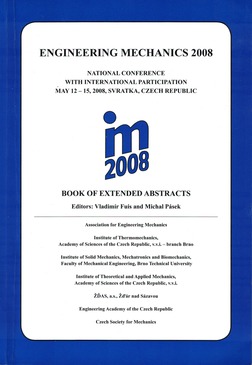Proceedings Vol. 14 (2008)

ENGINEERING MECHANICS 2008
May 12 – 15, 2008, Svratka, Czech Republic
Copyright © 2008 Institute of Thermomechanics, Academy of Sciences of the Czech Republic, v.v.i., Prague
ISSN 1805-8248 (printed)
ISSN 1805-8256 (electronic)
list of papers scientific commitee
pages 190 - +12p., full text
Long slender civil-engineering structures exposed to wind, especially decks of suspension bridges, their supporting elements, masts, towers and tall buildings are susceptible to vibrations under certain circumstances due to wind load action or due to special aeroelastic effects. Interaction between structural response and wind load, having the influence on the stability, is nowadays of basic importance in advanced technical design of such structures. Finding the stationary points and determining stability characteristics of a system is an important undertaking in any attempt to understand or to modify its dynamical properties. The importance can be understood and demonstrated with an example describing the aeroelastic system with gyroscopic as well as with non-conservative terms. We consider a nonlinear system with two degrees of freedom representing an interaction of bending and torsion of a slender beam vibrating in a cross flow. The cross-section shape makes possible to separate principal effects and the coupling of aeroelastic modes is caused solely by the flow around the structure. The system is auto-parametric and permits a semi-trivial solution of two types, one of which being unstable. Apart from that the response may be non-trivial in both phase coordinates. Conditions of existence of stationary points and their types are investigated using primarily the Lyapunov function. The procedure presented is applicable for Hamiltonian holonomic systems which are conservative, or non-conservative with certain limitations on the generalised forces. The singular points are classified with respect to their asymptotically stable/unstable character together with adequate physical interpretation. Attention is paid to attractive and repulsive areas surrounding these points. Using this background several types of post-critical response in non-linear formulation will be presented, such as stable/unstable limit cycles with various ratio of amplitudes of both components, or quasi-periodic response processes having a form of symmetric or asymmetric beating effects with strong energy trans-flux between degrees of freedom.
back to list of papers
Text and facts may be copied and used freely, but credit should be given to these Proceedings.
All papers were reviewed by members of the scientific committee.

 Powered by
Imce 3.20 © 2023, Pavel Formánek, Institute of Thermomechanics AS CR, v.v.i. [generated: 0.0116s]
Powered by
Imce 3.20 © 2023, Pavel Formánek, Institute of Thermomechanics AS CR, v.v.i. [generated: 0.0116s]